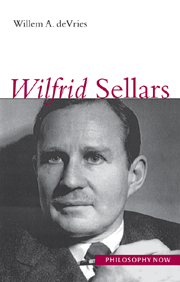Book contents
- Frontmatter
- Contents
- Preface
- Abbreviations
- 1 Sellars's philosophical enterprise
- 2 Sellars's philosophy of language
- 3 Categories, the a priori, and transcendental philosophy
- 4 Sellars's nominalism
- 5 Knowledge and the given
- 6 Science and reality
- 7 Intentionality and the mental
- 8 Sensory consciousness
- 9 Practical reason
- 10 The necessity of the normative
- Notes
- Bibliography
- Index
7 - Intentionality and the mental
- Frontmatter
- Contents
- Preface
- Abbreviations
- 1 Sellars's philosophical enterprise
- 2 Sellars's philosophy of language
- 3 Categories, the a priori, and transcendental philosophy
- 4 Sellars's nominalism
- 5 Knowledge and the given
- 6 Science and reality
- 7 Intentionality and the mental
- 8 Sensory consciousness
- 9 Practical reason
- 10 The necessity of the normative
- Notes
- Bibliography
- Index
Summary
The context for Sellars's philosophy of mind
‘Mind’ versus ‘sensorium’
Sellars's major impacts on twentieth-century philosophy have been in epistemology and philosophy of mind. As we turn to his philosophy of mind, there are some boundary issues that the reader should be aware of right from the start. How is the philosophy of mind delimited? In most post-Cartesian discussions, ‘mind’ covers both intentional and sensory states. Discussions of the “mind–body problem” focus indifferently on pains and thoughts. Sellars thinks this is a major mistake, for he recognizes two problems: the mind–body problem proper, which concerns the relation between intentional and bodily states, and the sensorium–body problem, which concerns the relation between sensory and bodily states. In Sellars's eyes, Kant's most important single lesson is that thoughts and sensations are different in kind, a lesson that too many philosophers still have not learned. Mental states, according to Sellars, are intentional states. Thus, purely sensory states are not mental states at all, a result that seems to run counter to the (tutored) intuitions of many philosophers. In his view we also need to distinguish between perceptual states – which are intentional states, although mixed with a sensory and non-conceptual component – and purely sensory states. Still, given the long tradition of including the sensory in the mental, the philosophy of mind includes de facto the treatment of the sensory and, accordingly, Sellars frequently uses ‘mind’ to include the sensory. His theory of the sensory will be the focus of Chapter 8. In this chapter we shall focus on the intentional.
- Type
- Chapter
- Information
- Wilfrid Sellars , pp. 171 - 202Publisher: Acumen PublishingPrint publication year: 2005



